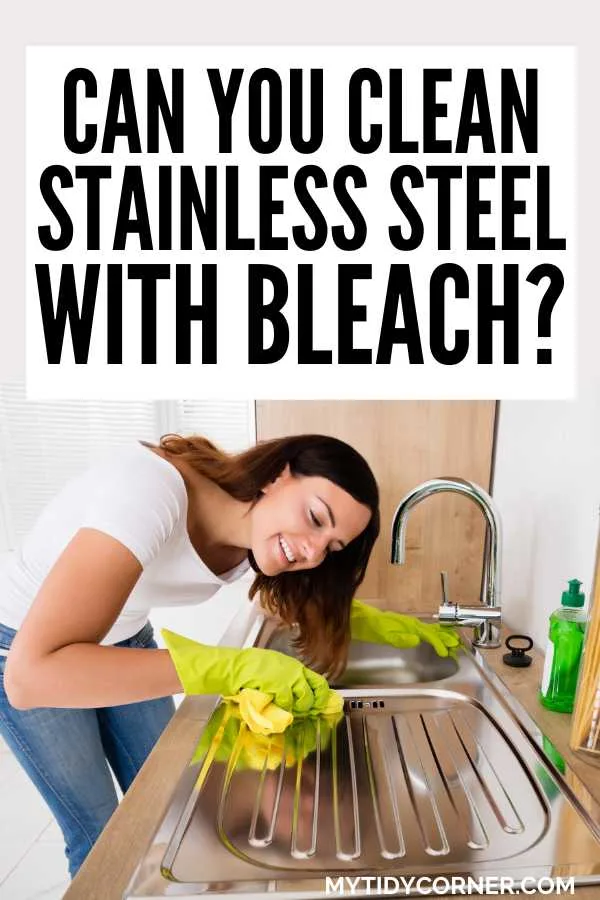Can You Clean Stainless Steel with Bleach?
Bleach has become a staple household cleaner in many households, especially since the pandemic. Its cleaning and disinfecting properties cannot be denied; however, can you use bleach on stainless steel?
While there are varied opinions on the matter, we present the facts here, plus the best way to to clean your stainless-steel appliances.
Although it may seem like a good idea, bleach should not be used on stainless steel. Strong chemicals like bleach can damage the chromium oxide layer. It’s best to clean stainless steel using regular dish soap and water.

If you have stainless steel appliances, or surfaces in your kitchen, you are likely among those on a constant quest to keep them clean and spotless. Fingerprints, oil, and even water droplets can leave unsightly marks on stainless steel, but is bleach the solution?
Related Article:
Can You Use Bleach on Stainless Steel?
Certain brand websites (such as Clorox) encourage the use of bleach on stainless steel; however, the fact is, bleach can cause serious damage to stainless steel appliances and surfaces.
And while it may be safe to use bleach on stainless steel that contains high concentration of molybdenum, the problem is that you may not know if your appliance has high level of molybdenum or not.
The damage is not superficial, instead, it is caused by corrosion to the elements that make up the stainless steel. It is possible to get rid of rust, but it is not easy.
And note that it doesn’t matter whether you use the bleach on the appliance on a regular basis or once in a while, or whether or not the bleach is diluted.
I don’t know about you, but I personally don’t think that the risk is worth it, especially when there are better options. It’s always wise to be cautious than sorry!
Why It is Not the Best Idea to Clean Stainless Steel with Bleach
Although it is technically possible to use bleach on stainless steel, it is not a particularly good idea. Let us look into the science behind what makes stainless steel so durable.
Stainless steel is made with iron and chromium alloy. Add to that any mixture of nickel, manganese, carbon, molybdenum, sulfur, nitrogen, copper, and silicon, and you have varying qualities of stainless steel for different purposes.
Because stainless steel comprises so many different parts, it is easy to see that using a harsh chemical like bleach could cause corrosion and impact one or more components.
When you use bleach on your stainless steel surfaces, it causes an electrochemical reaction to occur. The reaction can result in pitting, staining, and damage to your stainless steel surfaces.
You will know your surface has been damaged by bleach when the appearance is no longer shiny and clear. It will appear cloudy, brown, or rusty. In severe cases, it may have small spots or holes.
How to Restore Bleach Damaged Stainless Steel
Although stainless steel is known to be indestructible, it can be damaged by bleach. If you have accidentally damaged your stainless steel sink, fridge, surface, or any appliance, the damage is likely permanent, but know that there are ways to treat the affected area to some degree.
When bleach is left on stainless steel, it leaves marks and stains. The spots are typically dark in color and are not dirt. They are signs of corrosion. What has happened is that the integrity of the steel has been compromised.
For minor corrosion stains, it is helpful to scrub the area with a paste made using baking soda and water. Use a soft-bristled brush or rag, and rub the paste over the damaged spot. It may take a few minutes, but eventually, the stain should disappear.
Because stainless steel is not plated but the same all the way through, this light abrasion will not damage the surface any further.
Your approach will take a little more time for areas of more extensive damage, but you can use the same ingredients as with the minor stains. Moisten the damaged areas with water, then sprinkle generous amounts of baking soda to cover the marks completely.
Leave the baking soda to sit for about an hour. Spray a little water over the areas, then use a soft-bristled brush or clean rag to scrub the areas until the dark marks disappear.
Rinse the surface when you are done, and be sure to dry it.
If bleach has left holes in your appliance, there is nothing you can do to repair the damage. It is best to replace the item or continue to use it as is.
The Best Way to Clean Stainless Steel
Like most things, especially in the kitchen, simple is the best policy.
The best way to clean stainless steel is to use a mild detergent like dish soap and water. Use a clean rag soaked in the soapy water to wipe the appliance or surface down. Do not use harsh brushes or steel wool, as this may damage the surface.
Once you have covered the surface in soap, rinse the suds with clean water. It is best to use a clean, wet rag for this. You may need to rinse your rag and repeat the process a few times until all the soap has been removed.
Dry the surface with a dish towel and marvel at the shine.
You can also use baking soda. I personally like using baking soda to clean our stainless sink. Not only does it do a great job, making the sink look sparkling clean, but it also doesn’t leave our kitchen smelling like bleach.
Conclusion
It is not a great idea to clean stainless steel with bleach because it causes corrosion, which damages the appliance. Appliances mildly damaged by bleach can be repaired to some degree using baking soda. It is best to clean stainless steel using a mild detergent like dish soap.
Did you find our answer to the question, “can you use bleach on stainless steel” helpful? Leave your comment below.

